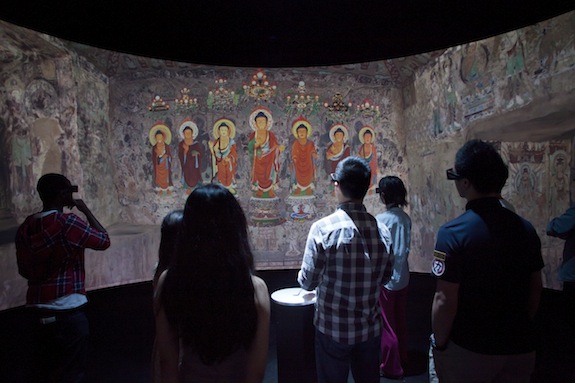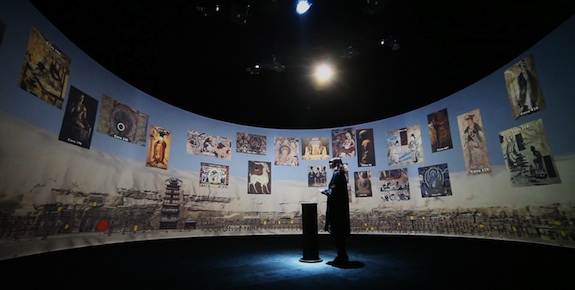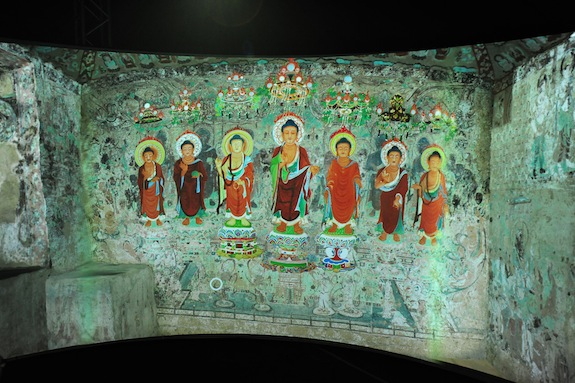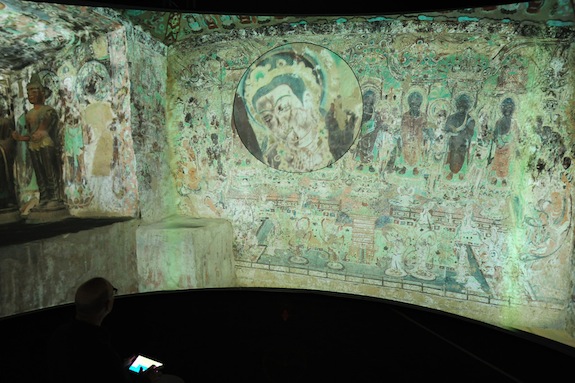Video: Take a Virtual 3D Journey to Visit China’s Caves of the Thousand Buddhas
Video: Take a Virtual 3D Journey to Visit China’s Caves of the Thousand Buddhas
![]()
This week, if you take a stroll through the Haupt Garden, past the Sackler Gallery and into the Moongate Garden, you’ll come upon something you likely won’t see everyday: a 1500-year old intricately painted Buddhist cave from northwest China. Okay, but not really. In a remarkable marriage of the ancient and the high tech, the Sackler welcomes an innovative and precise 3D digital representation of one of the Caves of the Thousand Buddhas, also known as the Mogao Caves, a UNESCO World Heritage Site that is one of the finest examples of Buddhist art in existence.
“There are over 600 caves in this escarpment, and they were painted over a period of about 1,000 years,” says Jeffrey Shaw, a professor at the City University of Hong Kong, who created the digital exhibition Pure Land: Inside the Mogao Grottes at Dunhuang, along with the Dunhuang Academy. “It is certainly one of the great art treasures of the world, and what we have here is a prototype for being able to explore the caves using digital data.”
Until you visit the exhibition, now shown outside China for the first time, you might be tempted to dismiss it as a gimmicky sideshow. But once you step inside the darkened tent and position the 3D glasses on your nose, the 360-degree virtual cave comes to life. It is utterly unlike the supposedly 3D experience you get, say, in a movie theater. Standing inside the tented chamber and seeing the richly detailed paintings and rock faces jut out at you from all sides, it really feels as though, if you reached out, you’d feel weathered millennial aged stone, rather than a smooth plastic screen. The digital cave, in short, is unnervingly lifelike.
Located at a natural oasis on the Silk Road—a crucial trade route linking China, western Asia and India from roughly the 2nd century BC through the 1300s—the Mogao cave complex was an ancient holy site where Buddhist monks practiced meditation. Over the centuries, they carved hundreds of chambers into the rock escarpment and filled them with intricate paintings. One cave of note, known as Bhaisajyaguru’s Eastern Paradise (now called Cave 220), is painted with seven figures known as medicine Buddhas, along with other traditional images such as incense burners, animals, dancers and musical instruments—and is now digitally represented as part of the new exhibition.
The virtual project began with painstaking work done by teams from the Dunhuang Academy, located at the site of the caves, in digitizing them over the course of several years. “They do a laser scanning of each of the caves, and they do ultra high resolution photography of the paintings,” Shaw says. The group has collected this data for a few dozen of the several hundred grottoes, but has only produced a fully-interactive virtual 3D exhibit for the one cave thus far.
The digital interface is controlled by a custom app installed on an iPad mini at the center of the room, which allows a tour guide to select from a menu of different options for displaying the work. It initially appears as a dark room, with a virtual flashlight’s beam bouncing around and illuminating small portions of it. Then, suddenly, the virtual house lights come up, and the six projectors and next-generation 3D technology provoke a wave of oohs and aahs from the tour groups crowding in to see it this week.
The fact that the entire experience is virtual gives visitors superpowers when exploring the cave. With a tour guide’s tap on the iPad, the group can suddenly move up to the ceiling, zoom in on a particular element with a massive magnifying glass or even animate elements of the paintings, bringing dancers or musical instruments out of the ancient painting to seemingly hover and perform in midair.
These capacities also allow visitors to experience the work in a pristine form unavailable at the actual cave. With another click, the seven medicine Buddhas are transformed, their dull pigments becoming vivid colors. “Here, the Buddhas have been virtually repainted to match the color quality of the original paintings,” Shaw says. “This is based on research by the Dunhuang Academy looking at what the original coloration would have been.”
One of the key motivations for the innovative project is conservation. “The Chinese want to reduce the amount of tours in the caves, because they are causing damage to them,” Shaw says. “The idea is that this will take some of the stress away from the touristic boom of interest in the caves themselves.” In addition to the touring exhibition, a permanent virtual cave will be installed at Dunhuang, along with the real ones, to accommodate the increasing level of cultural tourists without putting the grottoes at further risk.
“The Sackler is fast becoming a museum of the 21st century, taking the lead in adapting digital technology to a museum context,” said Julian Raby, the Director of the Sackler and Freer Galleries, at an event marking the Sackler Gallery’s 25th anniversary last week. “The ‘Pure Land’ project exemplifies the exhibition experience of the future.”
Pure Land: Inside the Mogao Grottes at Dunhuang will be open through December 9th. Timed tickets are available on a first-come, first-served basis at the Sackler Pavilion. The show will also return in the spring of 2013 for a longer-term installation at the International Center Gallery.
/https://tf-cmsv2-smithsonianmag-media.s3.amazonaws.com/accounts/headshot/joseph-stromberg-240.jpg)




/https://tf-cmsv2-smithsonianmag-media.s3.amazonaws.com/accounts/headshot/joseph-stromberg-240.jpg)